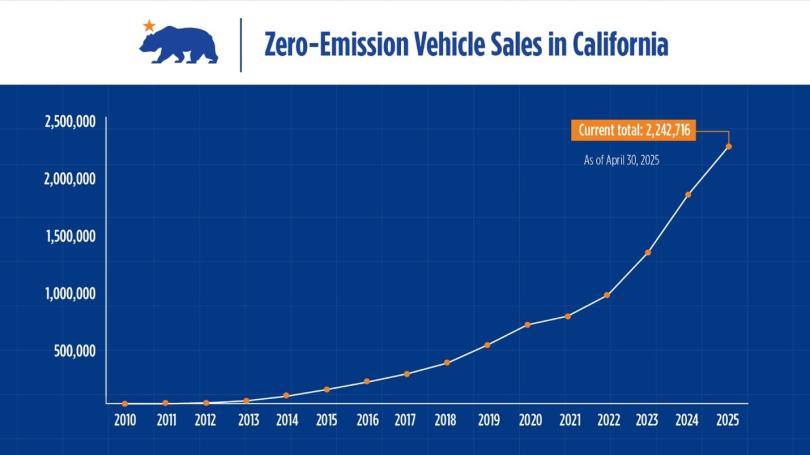For Immediate Release: May 16, 2025
WHAT YOU NEED TO KNOW:
Despite recent market disruptions, zero-emission vehicle (ZEV) sales remain strong in California, as car buyers continue to purchase alternatives to gasoline-powered cars and trucks.
SACRAMENTO — In the first quarter of 2025, Californians purchased 100,326 zero-emission vehicles (ZEVs) representing 23% of all new vehicle sales in the state. This marks a slight decrease in overall sales year-over-year compared to the first quarter of 2024, which was a record Q1 for the state. California eclipsed the 2 million ZEVs sold mark in 2024.
A Changing EV Market
The slight decline in ZEV sales in California was driven by a 21.5% drop in Tesla registrations compared to Q1 2024. Despite this drop, non-Tesla electric vehicle (EV) registrations grew by 14%.
The EV market is diversifying in California, with 147 EV models available in Q1, up from 105 models in Q1 of last year. Consumers are buoyed by more choices and are feeling confident in California’s growing ZEV infrastructure. Over 30% of new ZEVs sold in the U.S. are sold in California, according to the California Air Resources Board (CARB).
While California ZEV sales experienced a decline in Q1 2025, EVs were trending upward nationwide in Q1, with an increase of 11.4% year-over-year, according to Kelley Blue Book. The used EV market is also trending upward with Carvana reporting an 182% increase in used EV sales in 2024 year-over-year.
“The data shows Californians are still buying ZEVs in significant numbers, with over 100,000 electric vehicles purchased in the first quarter of 2025 alone,” said California Energy Commission (CEC) Chair David Hochschild. “Today, 94% of Californians live within 10 minutes of an EV charger. The Energy Commission is deploying funds to further expand the state’s charger network and ensure that EV charging is reliable, affordable and accessible to all Californians.”
“California’s clean vehicle market continues to show strong sales, and we are undeterred by this period of limited growth, which is a normal, anticipated part of the technology adoption cycle. The data shows nearly 1 in 4 new car shoppers are still choosing zero-emission models which is encouraging given current economic uncertainty,” said CARB Chair Liane Randolph. “While one manufacturer notably dropped in sales, other manufacturers’ sales collectively increased by 14%. From spacious SUVs to sporty sedans, automakers are delivering desirable options across every segment, and many new offerings are experiencing encouraging consumer uptake. Despite political headwinds domestically, zero-emission vehicles are the future internationally because they’re fast, fun and cheaper to fuel and maintain. America will not be left behind.”
Fighting to Keep Federal EV Infrastructure Funding
Last week, California announced a multi-state lawsuit challenging actions taken by the Federal Highway Administration (FHWA) to withhold billions of dollars approved by Congress to expand electric vehicle infrastructure. FHWA’s unlawful actions would cost the state more than $300 million, eliminate thousands of good-paying jobs, and stall California’s ZEV progress.
"The leading cause of air pollution in the state of California is from the transportation sector," said Hochschild at last week's press conference. "The innovation we’re seeing in the electric vehicle space is good for many things, but most importantly, it is good for public health...It’s imperative we finish the job."
California is the National Leader in Zero-Emission Vehicles and Infrastructure
California’s support for clean cars is unmatched. Despite federal funding challenges, the state has doubled down on improving the state’s charging network and making it easier than ever to buy an EV:
- Over 178,000 public or shared private electric vehicle charging ports have been installed throughout California, plus over 700,000 at-home charging ports.
- Grants and rebates for thousands of dollars are available for low-income Californians to purchase EVs. Learn more at ClimateAction.ca.gov or ElectricForAll.org.
State agencies are working to speed up charger deployment, cut through red tape, plan for the expected grid demand, and efficiently electrify charging stations through local utilities. This includes:
- Gathering better data on EV charger counts.
- Prioritizing shovel-ready projects for both state and federal incentives.
- Developing the Zero-Emission Vehicle Infrastructure Plan, a comprehensive plan that lays out the overall infrastructure strategy to meet California’s ZEV goals.
- Establishing reliability standards.
- Updating transportation energy forecasts.
California is tearing down barriers to ZEV deployment, spending billions to speed ZEV infrastructure deployment, and deploying infrastructure in hard-to-reach and low-income areas.
###
About the California Energy Commission
The California Energy Commission is the state's primary energy policy and planning agency. It has seven core responsibilities: advancing state energy policy, encouraging energy efficiency, certifying thermal power plants, investing in energy innovation, developing renewable energy, transforming transportation, and preparing for energy emergencies.
Newsroom
Media Contact
Media and Public Communications Office
MediaOffice@energy.ca.gov
(916) 654-4989

